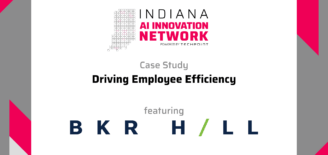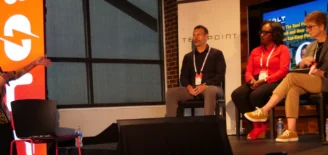Sprint Week: A Forcing Function of Innovation
Innovating at Speed
At High Alpha, we launch a new software company every 4 months. When I joined High Alpha as Director of Strategy & Innovation, my first task was to work with the partners to create the organizational discipline of innovating at this rapid pace.
All businesses have a momentum towards operating over innovating. It would be easy for us continue focusing on scaling our existing Portfolio Companies, but our business is to create businesses. Thus, we needed a “forcing function” to ensure we had a rhythm and mandate to innovate: the answer was Sprint Week.
The purpose of a “sprint” is to exponentially advance a concept, reducing ambiguity by rapidly developing and testing a prototype.
In High Alpha’s case, our “concepts” are B2B software companies that address user pain or fill market needs, which we have identified in specific industries. Teams to-date have chosen to build conviction by presenting their “prototype” as a pitch deck. Pitch decks are the language of venture capital and contain each of the key elements of a well-conceived business. During the sprint, we create a brand identity, user-validated click-through models of the product, and establish a price-point and go-to-market strategy, which are informed by product roadmap and headcount assumptions.
Rules of a Sprint
We’ve run Sprint Week six times now and while tactics have changed, we’ve found three rules that hold true:
1. Full Immersion
Three times per year, High Alpha’s 24 employees tell our Portfolio Companies that we are unreachable, ask our significant others to expect late nights, and put up out-of-office messages for one week. During a Sprint, there is singular focus on one task. We have all agreed that in order to make the most of the limited time we have together, we will each be all-in.
And not just physically; emotionally too! We have gone so far as to architect the emotional arc of the “entrepreneur’s journey” into the week itself. It’s easy to be in love with your concept on Monday morning; it’s tough to feel that way Tuesday evening after users have torn your prototype to shreds.
But at High Alpha we have a bias toward “yes.”
We don’t get the option to say “This isn’t a good investment.” At this early stage, it’s easy to kill ideas. What’s truly hard is to find a nugget of truth from a customer interview on which to build a business. So on Thursday, we have to stand up in front of our peers and passionately say, “If I had to start a business in this space, I would do it like this.”
2. Unstructured Time
It’s amazing how much can be accomplished in 72 hours when you’ve got nothing on your calendar. In most corporations, a typical meeting ends with: “That was very productive; let’s meet again next Tuesday to continue the conversation.” But in Sprint Week, having a limited amount of time drives a sense of urgency to accomplish more than your team ever believed it could.
Adding to the limited timeframe is intense, yet friendly, competition. Each team receives a different business concept, yet only one gets funded at the end of the week. While we don’t give marks for showmanship, we do have some great stories of the most sensational ways teams have attempted to prove that their idea was best: from distributing branded t-shirts, to visits from the Butler Bulldog, to pre-selling contracts from a Sprint Week deck, teams go to great lengths to stand out.

3. Cross-Functional Teams
There has been an abundance of discussion on the value of cross-functional teams, which I won’t attempt to repeat. Instead, I’ll share why we choose to staff our teams the way we do.
At the end of Sprint Week, the Partners are ultimately responsible for selecting which business concept to invest in. In order to balance the dynamics of the decision-making process, each Partner is placed on a different team. They act as “the decider” on any significant decisions, direct workstreams, and ultimately gain the conviction necessary to persuade the Investment Committee to progress or kill the concept.
Each team is then staffed with one person from each of the critical functions of a software business: product, design, business analyst, and marketing/sales. We believe that every member of the team is a “designer.” Design is a series of intentional choices and we design every aspect of our business: from the product itself to go-to-market strategy, hiring plans, and pricing. Every single member of our team participates regardless of their function – this is an opportunity to use all of the skills you possess, not just the ones you use in your day job.
Finally, we seed each team with subject-matter experts, buyers, users, business advisors, and others whose unique insights may help shape the business concept. We believe in getting critiques early and often — bringing in guests is one way that we architect for this type of feedback.
Keep Sprinting!
Sprint Week has become a mainstay at High Alpha, but it is just one step in our innovation process. Before each Sprint Week, my team spends months researching and framing problem statements and narrowing to the few that will compete in the sprint. After each Sprint, the Partners deliberate and decide on which concept will be launched as our next studio company.
For all of the work that was accomplished in the Sprint, its sole purpose is to establish the necessary conviction to launch a new software business. The work of refining the product, getting it into the hands of customers, and scaling the business still lies ahead of us. And we embrace these new challenges the same way we embraced the old ones: with a bias toward action.
About the Author
 Ryan Larcom loves bringing ideas into reality: whether turning sketches into products as an engineer & designer or as a strategist turning executives’ business aspirations into growth strategies & partnerships. Ryan serves as Director of Operations, where he works with High Alpha’s Leadership Team to provide world-class support for early-stage startups birthed out of the venture studio.
Ryan Larcom loves bringing ideas into reality: whether turning sketches into products as an engineer & designer or as a strategist turning executives’ business aspirations into growth strategies & partnerships. Ryan serves as Director of Operations, where he works with High Alpha’s Leadership Team to provide world-class support for early-stage startups birthed out of the venture studio.
At High Alpha, Ryan combines his passion for user-centric design with his strategic skills to lead the ideation & new business creation process that ultimately launches a new startup several times per year.


